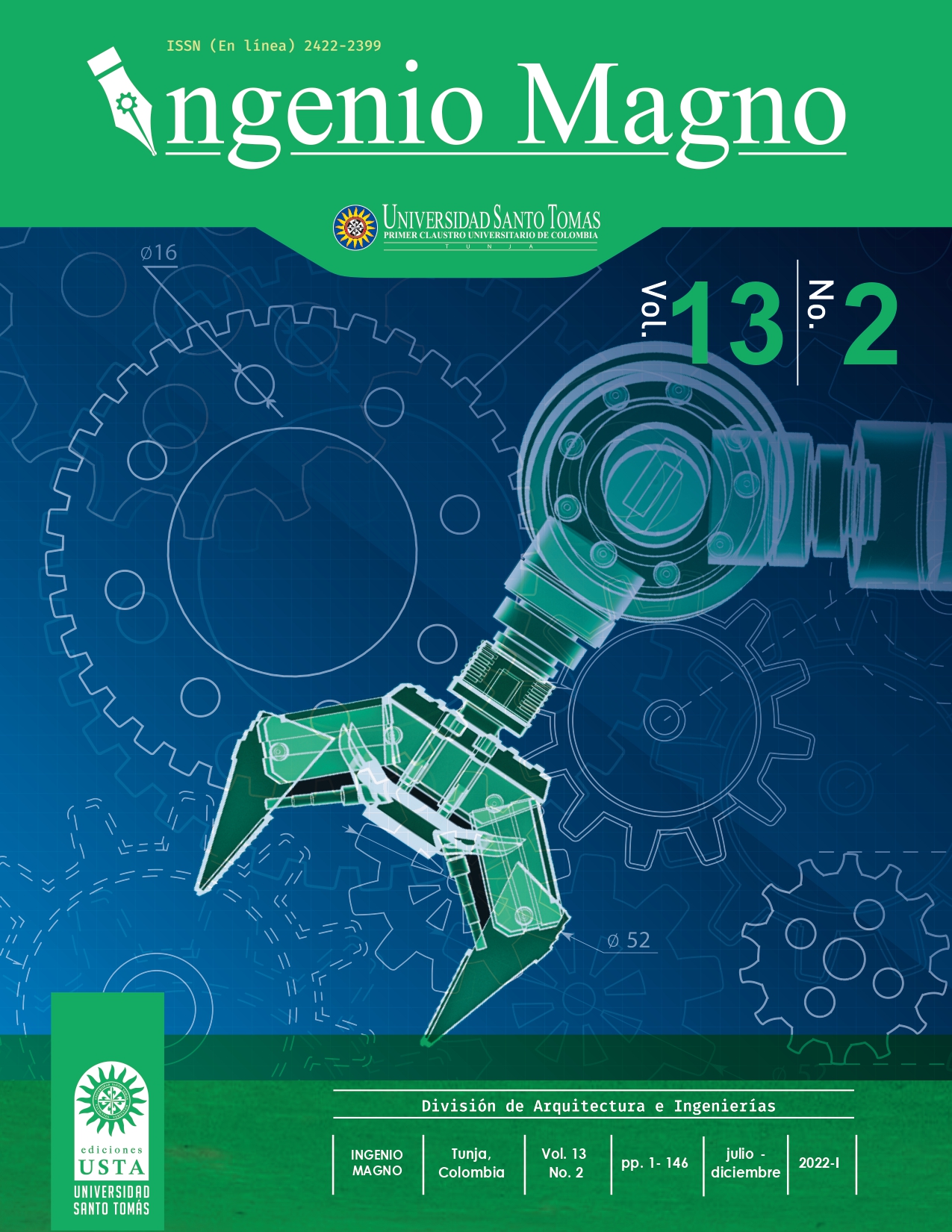Analysis of a total hip Prosthesis Proposal by the Finite Element Method under the Conditions of ISO 7206
Main Article Content
Abstract
Downloads
Article Details
DECLARATION OF ORGINIALITY OF SUBMITTED ARTICLE
With this document, I/We certify that the article submitted for possible publication in the institutional journal INGENIO MAGNO of the Research Center Alberto Magno CIIAM of the University Santo Tomás, Tunja campus, is entirely of my(our) own writing, and is a product of my(our) direct intellectual contribution to knowledge.
All data and references to completed publications are duly identified with their respective bibliographical entries and in the citations thus highlighted. If any adjustment or correction is needed, I(we) will contact the journal authorities in advance.
Due to that stated above, I(we) declare that the entirety of the submitted material is in accordance with applicable laws regarding intellectual and industrial property, and therefore, I(we) hold myself(ourselves) responsible for any complaint related to it.
If the submitted article is published, I(we) declare that I(we) fully relinquish publishing rights of the article to the University Santo Tomás, Tunja campus. As remuneration for this relinquishment of rights, I(we) declare my(our) agreement to receive two (2) copies of the edition of the journal in which my(our) article appears.
References
[2] Herrera P Sergio, “Diseño de prótesis de cadera”, tesis de licenciatura, Instituto Tecnológico de Celaya, 2016.
[3] M. S. Uddin, L. C. Zhang, “Predicting the wear of hard-on-hard hip joint prosthesis”, Wear. Vol.301. Issues 1–2. pp. 192 – 220. april – may 2013. Elsevier
[4] H. F. El´Sheikh, B.J. MacDonald, “Finite element simulation of the hip joint during stumbling: a comparison between static and dynamic loading”, Journal of Materials Procesing Technology. Vol. 143-144. pp. 249-255. december 2003. Elsevier
[5] F. J. Vigil, Guerrero Jorge, “Diseño y validación a fatiga de um vastago de revisión de prótesis de cadera empleando el método de los elementos finitos”, Anales de Mecánica de la Fractura. Vol. 2, No. 18, PP. 817-822. 2011.
[6] International Standard. ISO 7206-4:2010(E). Implants for surgery – Partial and total hip joint prostheses. Part 4: Determination of endurance properties and performance of stemmed femoral components. 2013
[7] International Standard. ISO 14242-3. Implants for surgery – Wear of total hip-joint prosthesese. Part 3: Loading and displacement parameters for orbital bearing type wear testing machines and corresponding environmental conditions for test. 2009.
[8] Fernando Mendoza Vázquez, Raúl Lesso Arroyo, Ramón Rodríguez Castro “Análisis visco-hiperelástico de prótesis intervertebrales implantadas en región lumbar”, XIV Congreso de la SOMIM, Septiembre del 2016 Mérida, Yucatán. México.
[9] Volodymir Pakhaliuk, Alexander Polyakov, “Improving the finte element simualtion of wear of total hip prosthesis spherical joint with the polymeric componente”, Universitetskaya Str., Russia, 2014.
[10] American Society for Testing and Materials. ASTM F2068 - 15. Standard Specification for Femoral Prostheses – Metallic Implants.
[11] Edwin Gamboa Poveda, Robinson A. Martinez, “Acero inoxidable 316 y 316L propiedades y características”, Fundación Universitaria Los Libertadores, 2011.
[12] Klaus-Dieter Kuehn, Werner Ege, “Acrylic bone cements: mechanical and physical properties”, Endomedicine Division, Wehrheim, Germany, 2005.
[13] Sindre Nordmark Olufsen, “Numerical analysis of primary stability on cementless hip prosthesis”, Norwegian University of Science and Technology, 2012.
[14] Rico Mosqueda Luis Antonio. Pruebas de desgaste en insertos protésicos de articulación de rodilla con control de temperatura. Instituto Tecnológico de Celaya, 2015.
[15] Richard G. Budynas, J. Keith Nisbett, “Diseño em ingenieria mecânica de Shigley”, McGrawHill, 9na ed.,2008.
[16] A. Fiorentino, G. Zarattini, U. Pazzaglia, “Hip prosthesis design. Market analysis, new perspectives and an innovate solution”, University of Brescia, Italia, 2013.
[17] Simesen-de Bielke H, González-Della Valle A “Vástagos cementados en la artroplastía de cadera: História y evolución”, Hospital Weill Medical College of Cornell University, New York, USA, 2011.
[18] Richard L. Drake, Wayne Vogl, Adam W. M. Mitchell, “Grey Anatomía para estudiantes”, ElSevier, 2005.

